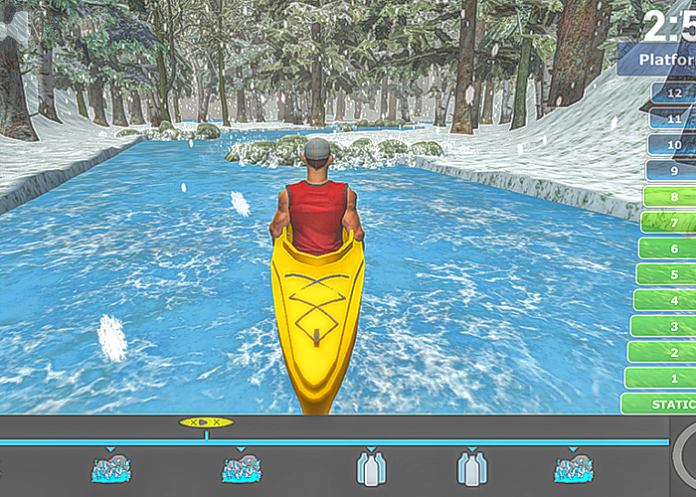A motion-sensor video game, Recovery Rapids, that allows patients recovering from a stroke to improve their motor skills and affected arm movements at home while checking in periodically with a therapist via telehealth, delivers improved outcomes similar to a highly regarded form of in-person therapy, known as constraint-induced therapy, while only requiring one-fifth of the therapist hours.
After a stroke, patients may lose feeling in an arm or experience weakness and reduced movement that limits their ability to complete basic daily activities. Traditional rehabilitation therapy is very intensive, time-consuming and can be both expensive and inconvenient, especially for rural patients travelling long distances to in-person therapy appointments.
“As an occupational therapist, I have seen patients from rural areas drive more than an hour to come to an in-person clinic three to four days a week, where the rehab is very intensive, taking three to four hours per session, and the therapist must be there the whole time,” said Rachel Proffitt, assistant professor at the University of Missouri School of Health Professions.
“With this new at-home gaming approach, we are cutting costs for the patient and reducing time for the therapist while still improving convenience and overall health outcomes, so it's a win-win. By saving time for the therapists, we can also now serve more patients and make a broader impact on our communities.”
Traditional rehab home exercises can be repetitive and monotonous, and patients rarely adhere to them. The Recovery Rapids game helps patients look forward to rehabilitation by completing various challenges in a fun, interactive environment, and the researchers found that the patients adhered well to their prescribed exercises.
“The patient is virtually placed in a kayak, and as they go down the river, they perform arm motions simulating paddling, rowing, scooping up trash, swaying from side to side to steer, and reaching overhead to clear out spider webs and bats, so it’s making the exercises fun,” said Proffitt. “As they progress, the challenges get harder, and we conduct check-ins with the participants via telehealth to adjust goals, provide feedback and discuss the daily activities they want to resume as they improve.”
Nearly 800,000 Americans have a stroke each year, according to the US Centers for Disease Control and Prevention (CDC), and two-thirds of stroke survivors report they cannot use their affected limbs to do normal daily activities, including making a cup of coffee, cooking a meal or playing with grandchildren.
“I am passionate about helping patients get back to the activities they love in their daily life,” Proffitt said. “Anything we can do as therapists to help in a creative way while saving time and money is the ultimate goal.”
The study was published in eClinical Medicine, which is part of The Lancet Discovery Science.
Study details
Video game rehabilitation for outpatient stroke (VIGoROUS): A multi-site randomized controlled trial of in-home, self-managed, upper-extremity therapy
Lynne V. Gauthier, Deborah S. Nichols-Larsen, Gitendra Uswatte, Nancy Strahl, Marie Simeo, Rachel Proffitt, Kristina Kelly, Roger Crawfis, Edward Taub, David Morris, Linda Pax Lowes, Victor Mark, Alexandra Borstad.
Published in eClinical Medicine on 16 December 2021
Summary
Background
Integrating behavioural intervention into motor rehabilitation is essential for improving paretic arm use in daily life. Demands on therapist time limit adoption of behavioural programmes like Constraint-Induced Movement (CI) therapy, however. Self-managed motor practice could free therapist time for behavioural intervention, but there remains insufficient evidence of efficacy for a self-management approach.
Methods
This completed, parallel, five-site, pragmatic, single-blind trial established the comparative effectiveness of using in-home gaming self-management as a vehicle to redirect valuable therapist time towards behavioural intervention. Community-dwelling adults with post-stroke (>6 months) mild/moderate upper extremity hemiparesis were randomised to receive one of 4 different interventions over a 3-week period: 5 h of behaviourally-focused intervention plus gaming self-management (Self-Gaming), the same with additional behaviourally-focused telerehabilitation (Tele-Gaming), 5 h of Traditional motor-focused rehabilitation, or 35 h of CI therapy. Primary outcomes assessed everyday arm use (Motor Activity Log Quality of Movement, MAL) and motor speed/function (Wolf Motor Function Test, WMFT) immediately before treatment, immediately after treatment, and 6 months later. Intent-to-treat analyses were implemented with linear mixed-effects models on data gathered from March 15, 2016 to November 21, 2019.
Results
Of 193 enrolled participants, 167 began treatment and were analysed, 150 (90%) completed treatment, and 115 (69%) completed follow-up. Tele-Gaming and Self-Gaming produced clinically meaningful MAL gains that were 1·0 points (95% CI 0·8 to 1·3) and 0·8 points (95% CI 0·5 to 1·0) larger than Traditional care, respectively. Self-Gaming was less effective than CI therapy (-0·4 points, 95% CI -0·6 to -0·2), whereas Tele-Gaming was not (-0·2 points, 95% CI -0·4 to 0·1). Six-month retention of MAL gains across all groups was 57%. All had similar clinically-meaningful WMFT gains; six-month retention of WMFT gains was 92%.
Interpretation
Self-managed motor-gaming with behavioural telehealth visits has outcomes similar to in-clinic CI therapy. It addresses most access barriers, requiring just one-fifth as much therapist time that is redirected towards behavioural interventions that enhance the paretic arm’s involvement in daily life.
See more from MedicalBrief archives:
Virtual reality as effective as stroke therapy
Dual therapy helps stroke patients recover use of limbs – clinical trial
No-hope' UK stroke patient rehabilitated in SA

